111 Years Of Liverpool Shipowning

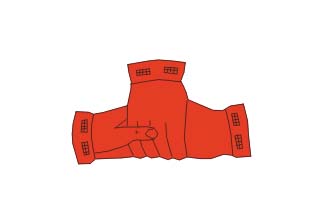 This famous line with the colourful red, yellow and black funnels was based in Liverpool, but originally had Spanish nationals as managers. The line was first established in 1863 in Liverpool as an owner of three masted sailing ships under the Spanish flag operating passenger and cargo services from Liverpool to the Spanish colonies in the Philippines and Cuba. The managing partnership of Olano, Larrinaga & Company in Liverpool had as its principals the 35 year old Ramon de Larrinaga, a master mariner and the son of a wealthy Basque merchant, and Jose Antonio Olano, a fellow Basque master mariner.
This famous line with the colourful red, yellow and black funnels was based in Liverpool, but originally had Spanish nationals as managers. The line was first established in 1863 in Liverpool as an owner of three masted sailing ships under the Spanish flag operating passenger and cargo services from Liverpool to the Spanish colonies in the Philippines and Cuba. The managing partnership of Olano, Larrinaga & Company in Liverpool had as its principals the 35 year old Ramon de Larrinaga, a master mariner and the son of a wealthy Basque merchant, and Jose Antonio Olano, a fellow Basque master mariner.
The shipowning company in Bilbao was Olano & Compania, which was renamed in 1870 as Compania de Navegacion a Vapor Olano, Larrinaga & Compania. In April 1871, the first steamer entered service from the Sunderland yard of Oswald & Company as Buena Ventura of 1,763 grt on dimensions of length 278 feet by beam of 34.4 feet, and powered by compound two cylinder steam engine by the builders giving a service speed of eleven knots. She was the first steamer under the Spanish flag to pass through the Suez Canal, and the company fleet of sailing ships were then switched from the Philippines trade to the Cuban and Gulf of Mexico trades. Buena Ventura also became famous for her capture on 22nd April 1898 by a warship of an American battle squadron as the first hostile act in the Spanish – American War of 1898.
Legend has it that the white Larrinaga houseflag bearing three red clasped hands dates from this period of the construction of the Suez Canal. Juan de Longa, a master mariner and the brother in law of Ramon de Larrinaga had joined the other two partners in the enterprise, and the three partners were uncertain whether to gamble on a new steamer using the shorter route to the Philippines through the new canal, or play it safe and remain in sail. They decided to let a toss of a coin decide the matter, and it came down in favour of building the first new steamer, Buena Ventura (Good Luck). The partners shook hands on it, and the three hands of the handshake were to form the houseflag for well over one hundred years until the demise of the company in 1974.
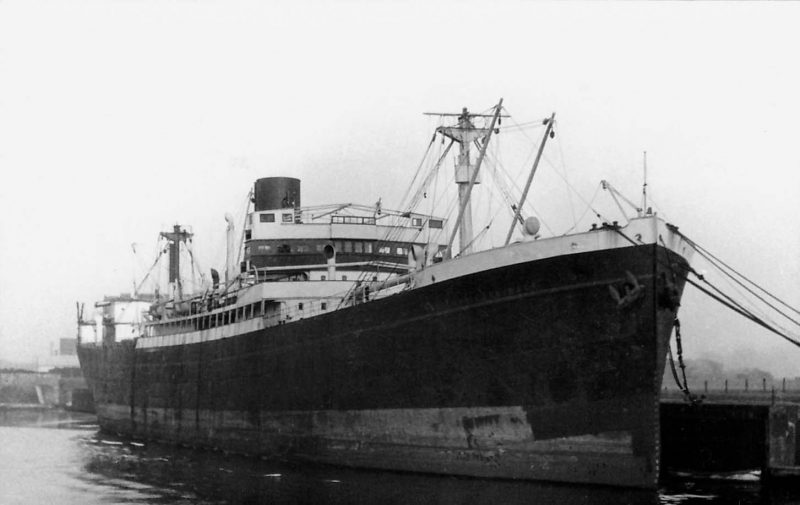
In 1880, the company lost the Manila mail contract to the Marquis de Campo, and three steamers were sold, first to the Marquis, and then three years later by the Marquis to Compania Trasatlantica of Barcelona. The main Larrinaga trade then became Liverpool to Havana outwards with general cargo and manufactured goods, together with tramping. In 1883, the Olano family sold their shares in the Liverpool company to the Larrinaga family, the company being renamed Larrinaga & Company. The trading routes were reorganised and a New York to Boston and Puerto Rico service began to operate. A new company was registered in Liverpool in 1898 as the Miguel de Larrinaga Steamship Company, with all Larrinaga steamers registered at Liverpool from this date, and services to Montevideo and the Plate began two years later in 1900. The Larrinaga fleet at the Millennium comprised ten steamers in Alava of 3,600 dwt, Anselma de Larrinaga of 6,500 dwt, Domingo de Larrinaga of 6,500 dwt, Maria de Larrinaga of 6,300 dwt, Niceto of 4,500 dwt, Ramon de Larrinaga of 4,500 dwt, Samoa of 9,250 dwt, Saturnina of 4,500 dwt, Telesfora of 6,250 dwt and Teodoro de Larrinaga of 6,300 dwt. Alava had been trapped at Havana for five months during the Spanish American War of 1898.
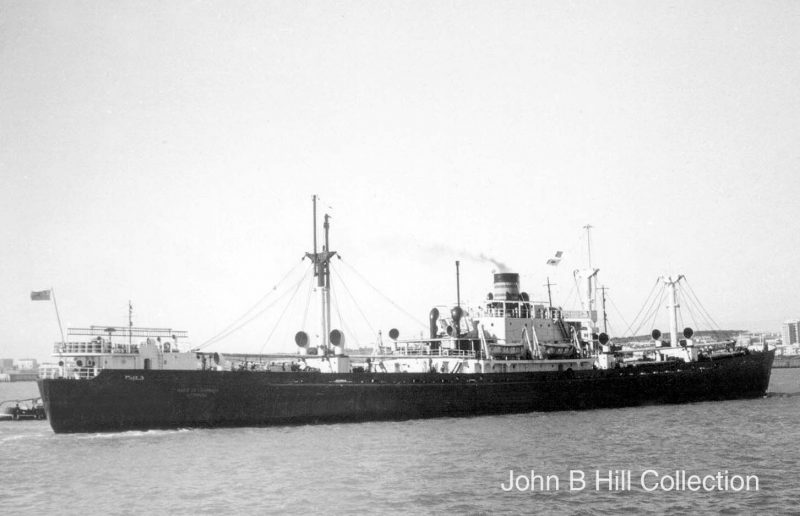
Eleven sailing barques and steamers were built by the Doxford yard at Sunderland for Larrinaga, including the two decker Alava completed in 1879 with a fo’c’stle of length 38 feet, a bridge deck of length 72 feet and a poop of length forty feet on an overall length of 320 feet, and a compound two cylinder steam engine fed with steam by two double ended boilers. Niceto and Saturnina of 1884 had longer bridge decks of eighty feet on an overall length of 340 feet, with their holds separated by three transverse bulkheads, and a service speed of eleven knots from compound two cylinder steam engines fed with steam from two double ended boilers.
Samoa was not a Doxford ‘Turret’ ship with a bottle shaped hull to lower her Suez Canal charges, but had been fitted out by the Doxford yard in Sunderland at the same time as the first ‘Turret’, appropriately named Turret, was launched on 19th November 1892. Samoa was ordered for Crow, Rudolf & Company of Liverpool, and was purchased by Larrinaga in 1898, but was considered too large for the available trade, and was sold in 1901 to the United States Government Army Transport Service to supply American Pacific bases from San Francisco. She had a fo’c’stle of length 42 feet, a bridge deck of length 91 feet, and a poop of 33 feet on an overall length of 445 feet, with one deck and a spar deck, three transverse bulkheads with water ballast carried in her cellular double bottom, and was powered by a triple expansion steam engine fed with steam from three double ended boilers.
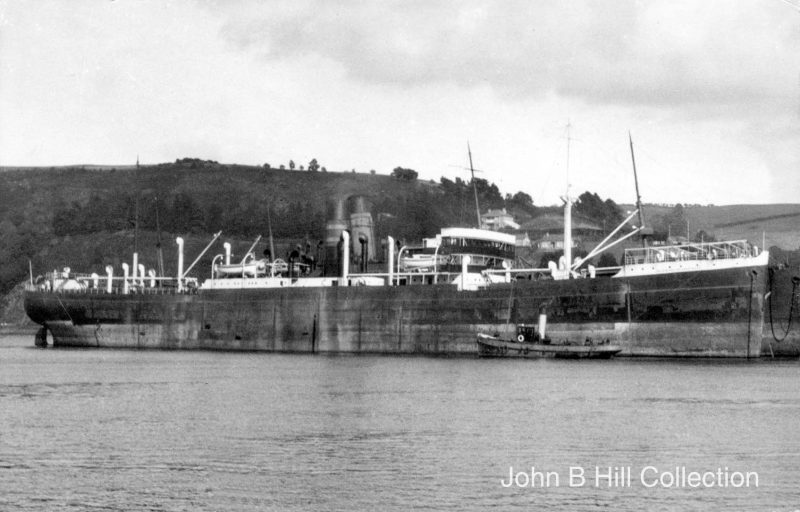
Anselma de Larrinaga of 6,500 dwt was launched on 12th March 1898 as the first of sixteen steamers from the Port Glasgow yard of Russell & Company, the last being launched in 1920. She had a fo’c’stle of length 44 feet, a bridge deck of length 96 feet and a poop of 48 feet, and was powered by a triple expansion steam engine fed with steam from two single ended boilers and manufactured by Dunsmuir & Jackson of Glasgow.
Larrinaga Homeward Cargoes
The main homeward cargoes were cotton and grain, but during the sugar harvest season of November to April, some occasional cargoes of sugar were carried homewards from Cuba. Cuba was ruled by Spain from the 16th century until 1898 when the island was ceded to the U.S.A. following the defeat of the Spanish forces in the Spanish American War. Cuba became an independent republic on 20th May 1902, but the U.S.A. retained its naval bases at Guantanamo Bay, and until 1934, the right to intervene in the internal affairs of Cuba. Sugar cane production became hugely important to the economy of the island, with Cienfuegos on the central south coast and Caibarien on the central north coast having large reducing plants to produce large amounts of sugar and sugar products for export. In the final years of the Larrinaga tramping era in the early 1970s, Cuban sugar, rum and molasses accounted for 87% of its exports. The Cuban sugar industry continues to the present day to be a giant industry, cutting down around fifteen million tonnes of sugar cane per year worth millions of Cuban pesos in exports.
British trade imports of sugar doubled from 35,000 tonnes per year in 1850 to 70,000 tonnes per year in 1890, mostly from Mauritius, Demerara (British Guiana) and the Leeward and Windward Islands. The Slavery Abolition Act of 1833 in London abolished slave labour in British plantations in British colonies, however the final end of slavery in Cuban sugar plantations, which supplied one third of the world’s sugar in 1850, did not come until the late 1890s. British sugar companies thus did not source their sugar imports from American owned plantations in Cuba, and Larrinaga steamers only occasionally carried homeward cargoes of sugar from the Cuban sugar ports of Cienfuegos, Caibarien, Santiago de Cuba and Havana.
Instead, from 1896, after the opening of the Manchester Ship Canal, they sailed to U.S. Gulf ports of Galveston, Houston and New Orleans to load cotton for Manchester. Texas has a big land area of 678,051 square kilometres, and Texan and worldwide cotton imports into Britain grew from 30,000 tonnes per year in the 1860s to 70,000 tonnes per year in the 1890s, with the majority of these totals supplied by Texan cotton growers as well as from Egypt. These were shipped from the U.S. Gulf ports of Galveston and Houston, both connected to the sea by long artificial channels with a depth of thirty feet in 1930, as well as the river port of New Orleans, with the cotton consigned to the Lancashire and Yorkshire cotton mills. Cotton exports from Galveston and Texan ports in 1930 were 1.3 million tonnes, with grain equally an important homeward cargo for Larrinaga steamers, with 1.1 million tonnes of wheat shipped from Texan ports in 1930.
Galveston is an island thirty miles long and no more than three miles wide, and like most of the Caribbean is a dangerous place for shipping during August and September each year. The hurricane that lashed Galveston in early September 1900 damaged two Larrinaga steamers that were loading wheat and cotton at the port.
Ramon de Larrinaga suffered deck damage, while Telesfora was pushed by the storm from her berth to collide with the steamer Whitehall, built in 1892 for Thomas Turnbull & Son by his own shipyard at Whitby. The Mate of Telesfora was killed when his vessel badly scraped along the hull of the Whitehall, and repairs at Galveston took six weeks to complete before Telesfora could sail for Manchester. The hurricane in September 1921 was also a killer at Galveston, claiming the lives of eight thousand local residents in the worst natural disaster to strike the U.S.A. in terms of lives lost, far greater than Hurricane Katrina that hit New Orleans in 2005.
World War I
The Larrinaga fleet had doubled in size to seventeen steamers by the outbreak of war on 4th August 1914. The British Government had requisitioned half of the fleet as colliers with fuel oil also carried in their double bottoms by 1917, when Germany began unrestricted submarine warfare against the Allied fleets. Six of the Larrinaga fleet were lost to enemy action and marine causes :-
Niceto de Larrinaga sunk on 6th October 1914 by the German cruiser Karlsruhe 100 miles south of St. Paul’s Rock while on a voyage from Buenos Aires to London with grain and general cargo, her crew were saved and were landed later in Tenerife.
Jose de Larrinaga torpedoed and sunk on 28th April 1917 150 miles WNW of the Fastnet by U81 while on a voyage from Galveston to Manchester with general cargo, 12 lost including Master.
Pilar de Larrinaga torpedoed and sunk in St. George’s Channel on 4th May 1917 two miles SSE of the Tuskar Rock while on a voyage from Galveston to Manchester with general cargo and wheat, 20 lost including Master.
Telesfora lost by collision in the English Channel on 29th May 1917 fifty miles off Barfleur Point near Le Havre with a French vessel.
Richard de Larrinaga torpedoed and sunk 15 miles SSE of Ballycotton Island (Eire) on 8th October 1917 by U57 while on a voyage from Manchester to Galveston in ballast, 35 lost including Master.
Miguel de Larrinaga foundered in the North Atlantic on 5th February 1918 400 miles off Cape Race while on a voyage from New York to the U.K. with hay and oats.
Before her loss, Richard de Larrinaga had previously been badly damaged on 23rd July 1917 in a collision with the British cruiser Devonshire off the American coast that required a month in dry dock to repair. The Larrinaga fleet at the end of hostilities numbered eleven steamers, having lost six steamers and 82 officers and men during the hostilities. Two years later, family members Miguel de Larrinaga and Domingo de Larrinaga were directors of Larrinaga & Co., based at 30, James Street in Liverpool, and were managing a fleet of fourteen steamers. These were Anselma de Larrinaga of 6,470 dwt, Asuncion de Larrinaga of 7,377 dwt, Domingo de Larrinaga of 6,716 dwt, Esperanza de Larrinaga of 8,350 dwt, Gloria de Larrinaga of 8,450 dwt, Maria de Larrinaga of 6,510 dwt, Mercedes de Larrinaga of 7,377 dwt, Minnie de Larrinaga of 9,050 dwt, Niceto de Larrinaga of 9,900 dwt. PIlar de Larrinaga of 10,988 dwt, Ramon de Larrinaga of 10,050 dwt, Telesfora de Larrinaga of 10,050 dwt, Ventura de Larrinaga of 8,480 dwt and Victoria de Larrinaga of 8,480 dwt.
Inter-War Years
The short boom and subsequent bad slump in tramp freight rates during 1920/22 affected the four Larrinaga services of Liverpool to Havana direct, Galveston to Manchester direct, New York to the river Plate, and river Plate to Cuba and the U.S.A., as well as general tramp voyages. Two vessels were lost to marine causes in the early 1920s with another vessel sold out of the fleet in 1924, these three being replaced by three purchased vessels, together with seven new vessels completed by shipbuilders on the Clyde and at Danzig throughout the 1920s decade. Esperanza de Larrinaga of 8,350 dwt, and completed at Port Glasgow in 1907, was lost in a hurricane in February 1921 while on a voyage from Galveston to Reggio in Italy with wheat. Nothing more was heard from her after a bunker stop at Norfolk (Va) on 2nd February 1921 with the loss of her 35 crew. Ventura de Larrinaga loaded 8,480 tonnes of sugar at Cienfuegos in Cuba for the U.K. but became stranded on the notorious Mouchoir Bank to the north of Haiti on 29th April 1922. She was abandoned by her crew after three days aground and they were safely picked up by an American steamer.

The trading profits of the company were elusive throughout the 1920s, and with high prices still being estimated by British shipbuilders, an order for three tramp steamers of 8,130 dwt was placed with the Schichau yard at Danzig for delivery in 1924/25. Ena de Larrinaga, Miguel de Larrinaga and Sylvia de Larrinaga had dimensions of length 405.0 feet, moulded beam of 52.9 feet and depth of 24.6 feet. Three purchased vessels in 1927 included two fine steamers from the Sunderland yard of Short Brothers, and purchased from Prince Line headed by Sir James Knott of North Shields. Burmese Prince of 8,020 dwt, completed in 1911, was renamed Lucille de Larrinaga, and Moorish Prince of 9,300 dwt, completed in 1914, was renamed Anselma de Larrinaga. The trio of purchased vessels was completed in July 1927 with the purchase of the Canadian built Loch Tay of 8,350 dwt from the Tonsberg fleet of A. Monsen, renamed as Jose de Larrinaga. A quartet of new steamers of around 9,000 dwt was launched during 1929 by Clyde yards as Rupert de Larrinaga, Richard de Larrinaga, Maria de Larrinaga and Domingo de Larrinaga on dimensions of length 415 feet, moulded beam of 55 feet and depth of depth of 24.2 feet.
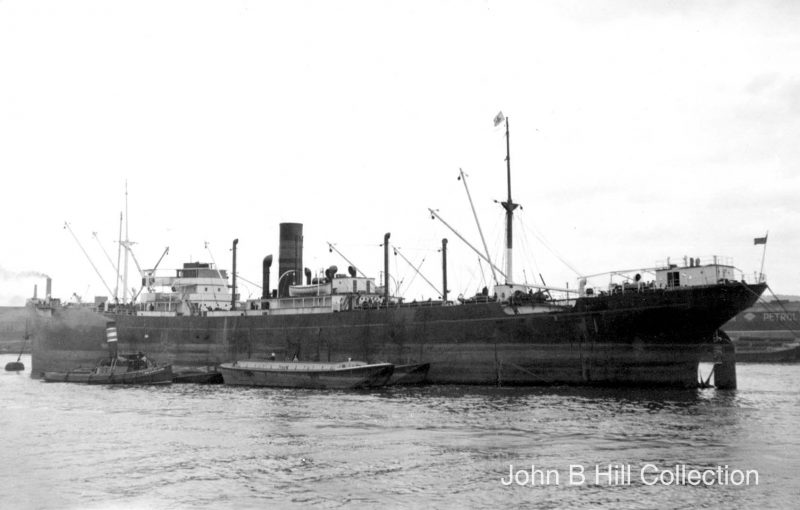
The Wall Street Crash of November 1929 and the subsequent deep trading Depression had a profound effect on the seventeen Larrinaga steamers, with the Galveston cotton trade almost at a standstill. Many of the fleet were laid up for up to three years at anchor or lay by berths at Manchester, Dartmouth, Fowey, Truro, Antwerp, Rotterdam and Bideford in Devon. A few lucky Masters and Mates were given employment as watchkeepers, living on board the ghostly ships until they were sold off cheaply or went for scrap, with four towed away to the breakers yards in 1934. The situation was extraordinary and far from satisfactory, and at a meeting of shareholders on 27th October 1931, the Larrinaga family directors stated that only three steamers were needed for the cotton trade into Manchester, compared to over a dozen steamers in 1929 to handle 1.3 million tonnes of cotton exports, with the lion’s share of one million tonnes being shipped from Galveston. It was decided to register all of the fleet under one new company, the Larrinaga Steamship Co., to save administration charges.
Pilar de Larrinaga of 10,990 dwt, completed in Japan in 1918 as War Nymph and purchased by Larrinaga a year later, had spent six and one half years laid up at Dartmouth from 20th February 1930 when she was finally reactivated. She arrived in tow at Cardiff for dry docking in August 1936 and then loaded coal at Barry for the Plate. She made two more voyages in the coal out, grain home trade to the Plate, returning towards the end of April 1937 to Antwerp to discharge. She then made a 53 day ballast voyage out to Port Adelaide, arriving on 23rd June 1937, to load 8,800 tonnes of bulk wheat at Port Pirie and Wallaroo for the U.K., with the Australian press giving her a good write up as the ship that had spent one third of her life laid up.
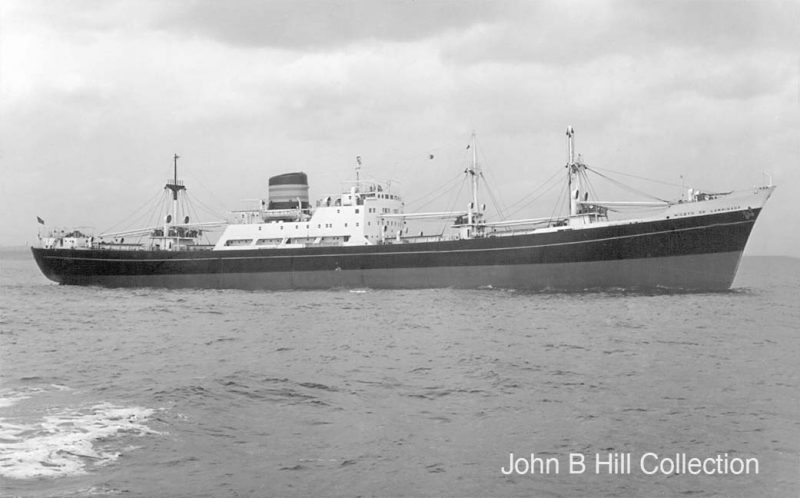
A reduced fleet of only thirteen steamers was required when trade returned to normality in 1936. Tramping voyages to ports in Africa, Asia and the Pacific became more common along with the regular Caribbean, North and South American voyages. Maria de Larrinaga foundered on 8th February 1939 during a storm 700 miles south east of Cape Race while on a voyage from Houston to Queenstown for orders with wheat, and the loss of her entire crew. The fleet at the outbreak of war on 3rd September 1939 included one vessel, Niceto de Larrinaga of 9,900 dwt, voyaging up the west coast of Mexico and the U.S.A. to Vancouver to load a deck cargo of lumber, timber and grain in the holds.
World War II
This fine Liverpool fleet was to be decimated over the next 6 years, with 9 vessels out of a pre-war total of 12 vessels lost to enemy action and marine causes.
Domingo de Larrinaga was sunk by the 6 inch guns of the raider Pinguin in the South Atlantic to the south of the Equator on 31st July 1940 while on a voyage from Bahia Blanca to Freetown, Belfast and Hull with grain, with 8 crew killed in the shelling and the remaining thirty including Capt. Chalmers taken prisoner. Convoy SC2 sailed from Sydney, Nove Scotia on 25th August 1940 with 53 ships that were badly mauled by the first wolf pack attack by several U boats of the war.
Jose de Larrinaga was sunk on 7th September by U47 with the loss of her 40 crew members and her cargo of steel, linseed and scrap iron that had been loaded in New York. The fleet was not even safe in port, with three nights of saturation bombing of London Docks beginning on 7th September 1940 claiming Minnie de Larrinaga. The wreck was loaded up with rubble from damaged London buildings and towed to Dover to be scuttled to block the western entrance to the port.

Ena de Larrinaga slowed down on her voyage from Hull to Buenos Aires with coal and general cargo when she came across the wreckage of the Anchor Line passenger ship Britannia to the south of the Equator on 5th April 1941. She was thus a ‘sitting duck’ for U105, which put a torpedo into her engine room killing 5 engineers. Capt. Craston and the remainder of the crew got away in two lifeboats, one was adrift for 11 days before being sighted by a Belgian steamer, the other lifeboat reached the Brazilian coast in thirteen days.
Richard de Larrinaga was bombed at anchor off the Tyne on 12th May 1941 while waiting to join a convoy to the St. Lawrence, and was beached on the Herd Sands at South Shields where she broke in two and was lost.
Rupert de Larrinaga loaded coal and general cargo in the Tyne in early July 1941, but was sunk a week later shortly after leaving Gibraltar bound convoy OG67, fortunately her crew were rescued. Telesfora de Larrinaga survived the war, despite being badly damaged in a severe bombing raid on the night of 19th/20th March 1941 which took 6 months to repair. She grounded at Naples on 22nd February 1944 but was subsequently refloated and repaired again.

The 13 ship SL87 convoy sailing from Freetown on 14th September 1941 lost 7 of their number, including Niceto de Larrinaga 8 days later to a torpedo from U103, killing 3 men, and with the loss of her valuable cargo of palm kernels, groundnuts and manganese ore. Freetown convoys were badly hit by U boats waiting offshore, and they also claimed Sylvia de Larrinaga on 14th August 1942 while sailing independent of convoy on a voyage from Durban to Baltimore and New York with manganese ore with the loss of her Master and 2 crew members.
Ramon de Larrinaga had capsized in the Delaware river on 9th February 1941 with the loss of 2 crew members, but was refloated nearly 3 weeks later and repaired and then sold to the Ministry of War Transport and renamed Empire Mersey. She was sunk on 14th October 1942 to a torpedo from U618 in convoy SC104 in the North Atlantic while on a voyage from New York to Manchester with Government stores with the loss of her Master and 15 crew members and 2 gunners from her crew of 51 plus 4 gunners.
Twenty vessels were managed for the British Government by the Larrinaga Steamship Co. during the war, with Empire Hail, Empire Blanda, Empire Bruce, Ocean Voice, Ocean Venture, Empire Story, Empire Clough, and Fort Concord being lost together with some or all of their brave crews. The company was left at the end of the war with only the owned Pilar de Larrinaga, Miguel de Larrinaga and Telesfora de Larrinaga, the latter vessel in a badly damaged condition after an explosion in April 1945 when she was serving as a coal hulk at Bari, and was undergoing repairs at Taranto at the cessation of hostilities 4 months later.
Post-War Years
The war losses were only half restored from 1947 as there was no hope in the changed circumstances of restarting the company liner services from Liverpool to Havana, Galveston to Manchester, and those from the river Plate to Caribbean and Eastern Seaboard U.S.A. ports. Future business would only be tramping and the charter of good quality tonnage to liner companies, with six new cargo-liners completed in post-war years for charter work. The three war survivors were sent tramping instead, with Pilar de Larrinaga making several iron ore voyage charters from Narvik to the Tees, Immingham or the Clyde during 1948, and she was then sold off in August 1949. Telesfora de Larrinaga was sold off two months later, and Miguel de Larrinaga followed in March 1950 to German owners.

Five surplus ‘Liberty’ ships were purchased as a temporary ‘stop gap’ and renamed Maria de Larrinaga, Asuncion de Larrinaga, Ramon de Larrinaga, Domingo de Larrinaga and Miguel de Larrinaga. Miguel de Larrinaga traded in the tramp trades until sold in 1956, by which time two new good quality cargo-liners had entered service in 1954/55 as Ramon de Larrinaga and Richard de Larrinaga from the William Pickersgill & Sons yard at Southwick in Sunderland. Maria de Larrinaga was the only ‘Liberty’ type to trade on until the 1960s decade, serving Larrinaga for seventeen years. The six post-war cargo-liners completed for Larrinaga will now be described in some detail.
Ramon de Larrinaga And Richard de Larrinaga
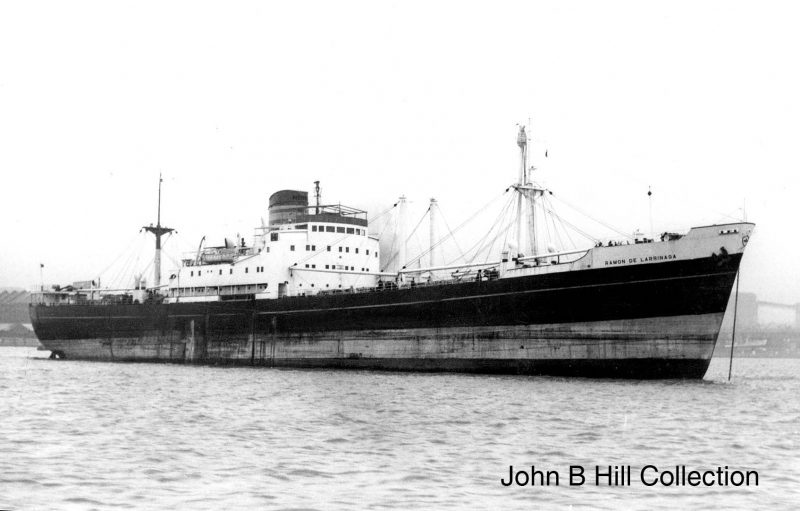
These two closed shelterdeckers of 10,000 dwt and 5,840 gross tonnage were completed in 1954/55 at Sunderland for economic operation at a moderate speed of twelve knots with a modest fuel consumption suitable for the long distance transport of bulk cargoes in the tramping and charter trades. They had five holds, three forward of the accommodation block and two aft, and were equipped with two masts and a set of posts with ten efficient derricks of ten tonnes capacity and a heavy lift derrick of 25 tonnes capacity on the foremast for use in lifting cargo into number two hold. The water ballast capacity was 3,500 tonnes, part of which could be carried in two deep vegetable oil tanks, port and starboard, aft of number three hold when on ballast voyages. They had overall lengths of 457.2 feet, moulded beam of 59.8 feet, and a summer draft of 25.8 feet. The grain cubic capacity was 595,347 cubic feet with 405,386 cubic feet in the five holds and 189,961 cubic feet in the five ‘tween decks, with the bale cubic at 560,696 cubic feet. The navigating bridges were fitted with the latest equipment including direction finders, electric signalling devices, gyro compass and radar.
The ‘midships accommodation was tastefully decorated and comfortably furnished in spacious rooms for the owner’s suite, Master, Chief Officer, and officers and crew. The Dining Room was aft on Bridge Deck with four tables each set for four persons, with the dayroom and bedroom of the Chief Officer forward on the starboard side, and those of the Chief Engineer forward on the port side, with the Officers Smoke Room placed centrally between these two suites. The Boat Deck had the dayroom and bedroom of the owner’s suite forward on the starboard side, and those of the Master on the port side. Wood veneered bulkheads with wooden furniture and serving cabinets were a feature of the accommodation. The galley and hospital were aft of the seamen’s and greaser’s cabins on the weather deck, while the laundry was aft on the poop. These two cargo-liners were powered by six cylinder four stroke single acting Harland-B & W diesels of 3,235 bhp to give the necessary speed to serve on charter to British liner companies, or on worldwide tramping voyages fixed on the Baltic Exchange.
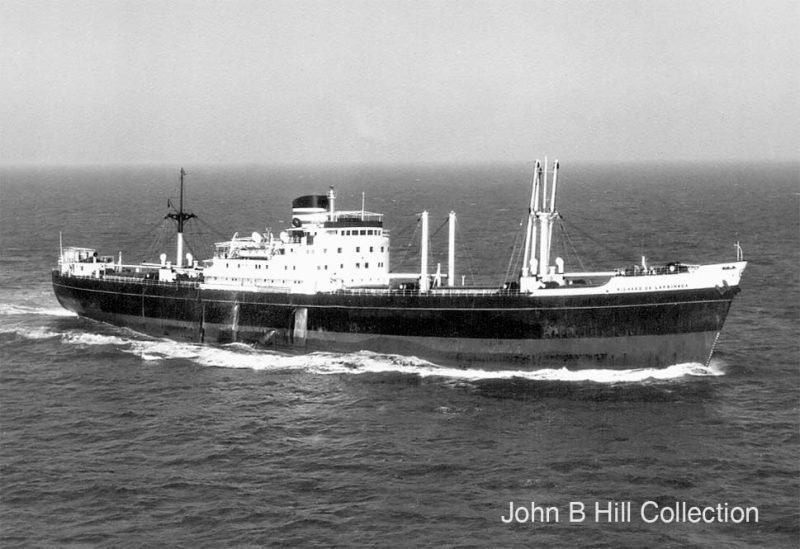
Niceto De Larrinaga
An order for a similar shelterdecker of the same length as the pair just described but two feet wider in the beam was then given to Short Brothers of Pallion in Sunderland. She was launched on 11th November 1958 as Niceto de Larrinaga, and completed in March 1959 powered by a Sulzer main engine of 7,800 bhp to give a service speed of 16.5 knots. She had a deadweight of 11,700 tonnes, but this earning capacity was boosted by 2,000 tonnes by the insertion of a 63 feet long section between numbers 2 and 3 holds at the Belfast yard of Harland & Wolff in 1964. An extra mast was added with two derricks and two winches to improve her attractiveness to British, Scandinavian and other foreign liner companies such as Klaveness of Norway and Saguenay Terminals of Canada. She also went tramping with voyage charters to load iron ore from Pepel to the U.K., Indian produce to Japan, lumber from Vancouver to the U.K., and sugar from Mauritius to the U.K. The maiden charter in March 1959 was a long one of over two years away from the U.K., and it had ended very badly as she was in collision in dense fog with the new French Shell tanker Sitala of 82,944 dwt in the English Channel on 23rd September 1961. Two crew members were killed when the force of the collision pushed her crumpled bow into number one hold, and she was helped into Portland by a British frigate and tugs, and then towed stern first to Ijmuiden for discharge. At the subsequent enquiry, it was stated that Niceto de Larrinaga had been travelling at half speed, too fast for the conditions, and that the collision was ‘radar assisted’ and her Master and two officers were censured.
Three SD14s
Ramon de Larrinaga and Richard de Larrinaga of 1954/55 were no longer competitive by 1969 in the charter markets, and were sold off to finance the first of three SD14s from Austin & Pickersgill of Sunderland. The SD14 was competitive in both the tramping and liner charter markets, and the Larrinaga Steamship Co. was the first British shipping company to place an order for one. The first Larrinaga SD14 was launched on 11th July 1969 as Rupert de Larrinaga at the Southwick yard and completed two months later, the second Larrinaga SD14 was launched on 2nd September 1970 at Southwick as Miguel de Larrinaga and completed two months later, and the third was launched on 22nd November 1971 at Southwick as Ramon de Larrinaga by Mrs. Ramon de Larrinaga and completed in early 1972.
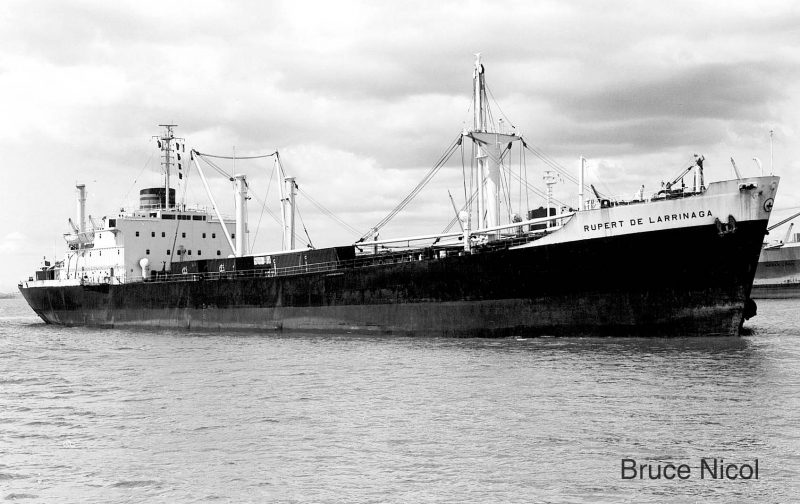
Finance and credit facilities were available for foreign flag owners placing orders for SD14s and other vessels built in Britain, but these were not available to British owners placing orders with British yards. Thus, the Larrinaga Steamship Co. had to finance this trio by themselves, but the competition for charters from State owned third world fleets was becoming intense, and Ramon de Larrinaga was sold after only eight months trading to George Vergottis of Piraeus and renamed Jade Bay. The older Niceto de Larrinaga was then sold two months later after seventeen years of service, leaving only two remaining SD14s in service in March 1973.
The steep oil price rises by the OPEC oil producing countries in November 1973 was the final nail in the coffin for the Larrinaga Steamship Co., and an offer was accepted of £3.05 million from George Vergottis for the two remaining SD14’s and the company itself in November 1974. The Larrinaga Steamship Co. was renamed as the Vergocean Steamship Co., and the two remaining SD14s were renamed as Vergray and Vergstar. The Larrinaga Steamship Co. and their wonderful funnel colours of the national colours of Spain thus disappeared from the high seas forever.
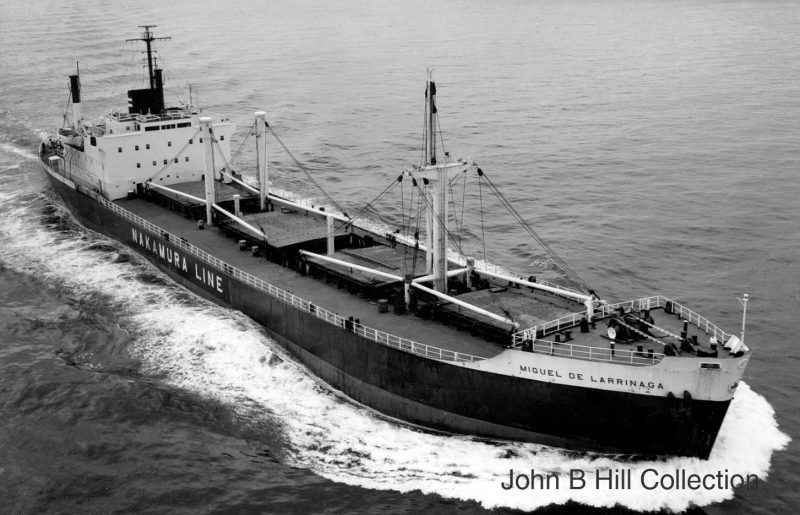
Postscript
The three Larrinaga family homes in Liverpool between Sefton Park and the Mersey were also later sold off, including ‘Villa Maria’ in Alexandra Drive, Sefton Park. They had been purchased in 1897 and had been richly decorated in some style, with silks, lacquer boxes and Chinese style furniture brought to Liverpool on the return voyages of Larrinaga ships in the Philippines trade that had called at Hong Kong and Singapore.
The Liverpool based shipping company had lasted 111 years, with their regular liner trades giving way to worldwide tramping and charters to liner companies in the thirty years after the end of World War II.
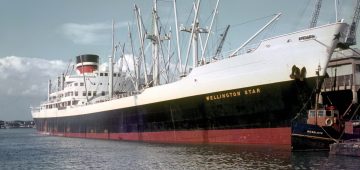



Comments
Sorry, comments are closed for this item